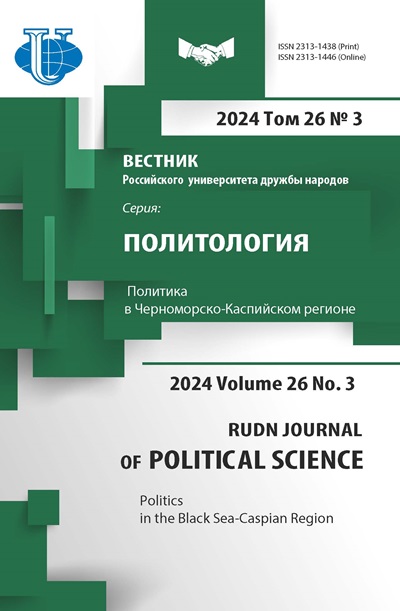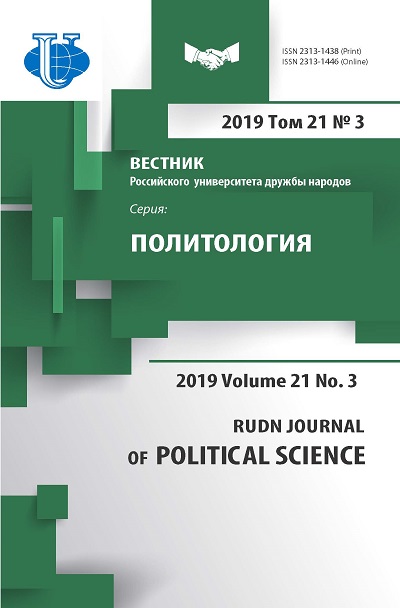The Use of Internet Technologies for Mobilizing the Voter Base: Features, Subjects and Prospects
- Authors: Antonov D.E1
-
Affiliations:
- Lomonosov Moscow State University
- Issue: Vol 21, No 3 (2019)
- Pages: 538-548
- Section: Some actual problems of political science
- URL: https://journals.rudn.ru/political-science/article/view/22063
- DOI: https://doi.org/10.22363/2313-1438-2019-21-3-538-548
Cite item
Full Text
Abstract
The article analyses the role of internet technologies in the process of voter base mobilization. One of the consequences of the reforms carried out in Russia will be mediatization of the electoral process. Modern approaches to understanding electoral mobilization are based on classical elitist concepts and the theory of mass society. Such perspective fails to identify individual actors of mobilization impact and analyze their own strategies. The author suggests a different way of looking at the problem: from the perspective of the neo-institutional approach. “Mobilization impact” can be interpreted as a form of subject-object interactions between different participants of the electoral process. The author identifies three main goals of mobilization interactions: attracting new supporters, encouraging a specific form of political activity, and prompting the choice of a certain position in the ballot. The author’s other objective is to assess the pattern of Internet technologies usage in the process of electoral mobilization. In the conclusion, the author pinpoints possible tendencies in the development of the voters’ Internet mobilization technologies. The perspective suggested by the author allows him to draw conclusions about what forms work with voters will assume as a result of the development of Internet communication technologies.
About the authors
Dmitry E Antonov
Lomonosov Moscow State University
Author for correspondence.
Email: a.dmitry.msu@gmail.com
Assistant Professor of the Department of History and Theory of Politics
Moscow, Russian FederationReferences
- Background to “Assessing Russian Activities and Intentions in Recent US Elections”: The Analytic Process and Cyber Incident Attribution. Analytical report. Office of the Director of National Intelligence. 06.01.2017. Available from: dni.gov/files/documents/ICA_2017_01.pdf. Accessed: 09.03.19.
- Volodenkov S. The Total Data as the Phenomenon of Formation of Political Postreality. Bulletin of Omsk University. Series “Historical Sciences”. 2017; 3: 409—415 (In Russ.).
- Irkhin I. Elections of the 45th President of the USA: Key Features, Techniques, Results. Ars ADMINISTRANDI. 2017; 1: 111—131 (In Russ.).
- Easton D. Categories of System Analysis of Policy. Political Science: reader. Comp. by M.A. Vasilik, M.S. Vershinin. Moscow: Gardariki; 2000: 319—331 (In Russ.).
- Castels M. The Power of Communication. Moscow: Higher school of Economics; 2016. 564 p. (In Russ.).
- Communicative Technologies in the Processes of Political Mobilization. Eds. V. Achkasova, G. Melnik. Moscow: FLINTA: Science; 2016. 248 p. (In Russ.).
- Meyer T. Media Democracy. How the Media Colonize Politics. Oxford: Polity; 2002. 184 p.
- Nesmashny A. Internet-technologies in Politics and Political Information Internet-technologies: Differences in Essence and Content of the Notions. Society and Authority. 2017; (2): 59—64. doi: 10.22394/1996-0522-2017-2-59-64 (In Russ.).
- Program “Digital Economy of the Russian Federation”. Available from: static.government.ru/ media/files/9gFM4FHj4PsB79I5v7yLVuPgu4bvR7M0.pdf. Accessed: 09.03.2019 (In Russ.).
- Way L.C., Casey A. Russian Foreign Election Interventions Since 1991. PONARS Eurasia Policy Memo No. 520. March 2018. Available from: ponarseurasia.org/sites/default/files/policy-memos-pdf/Pepm520_Way-Casey_March2018.pdf. Accessed: 09.03.2019.
- Safronov A. Radical Populism and Mobilization Participation. Moscow: KomBook; 2006. 245 p. (In Russ.).
- Svinin A. Social Networks as Internet-technologies in Electoral Campaigns: International View. RUDN Journal of Political Science. 2013; 2: 157—163 (In Russ.).
- Special Report on the Results of the Presidential Election in the Russian Federation (2018) in Terms of Violations of Russian Electoral Sovereignty. 2018. 46 p. Available from: council.gov.ru/media/files/2uQuCAAwoWu0B8tiDeDExn5x9CtBkTDV.pdf. Accessed: 09.03.2019 (In Russ.).
- AmoCRM. Available from: amocrm.ru. Accessed: 09.03.2019.
- Bennett W.L., Manheim J.B. The One-step Flow of Communication. The Annals of the American Academy of Political and Social Science. 2006; Vol. 608; 1: 213—232.
- Bitrix24. Available from: bitrix24.ru/features/index.php. Accessed: 09.03.2019.
- Bond R., Fariss C., Jones J., Kramer A., Marlow C., Settle J., Fowler J. A 61-Million-Person Experiment in Social Influence and Political Mobilization. Nature. 2012; 489: 295—298.
- Herman E., Chomsky N. Manufacturing Consent: The Political Economy of the Mass Media. N.Y.: Pantheon books; 2002. 407 p.
- Innis H. The Bias of Communication. Toronto: University of Toronto Press; 2008. 226 p.
- Kwon K.H., Stefanone M.A., Barnett G.A. Social Network Influence on Online Behavioral Choices: Exploring Group Formation on Social Network Sites. American Behavioral Scientist. 2014; Vol. 58; 10: 1345—1360.
- Meyer T. Media Democracy. How the Media Colonize Politics. Oxford: Polity; 2002. 184 p.
- NationBuilder. Available from: nationbuilder.com. Accessed: 09.03.2019.
- Polis. Available from: polisinc.com. Accessed: 09.03.2019.
- Rosenau J.N. Turbulence in World Politics: A Theory of Change and Continuity. Princeton: Princeton University Press; 1990. 480 p.
- Thompson J.B. Media and Modernity: A Social Theory of Media. Cambridge; 1995. 328 p.
















